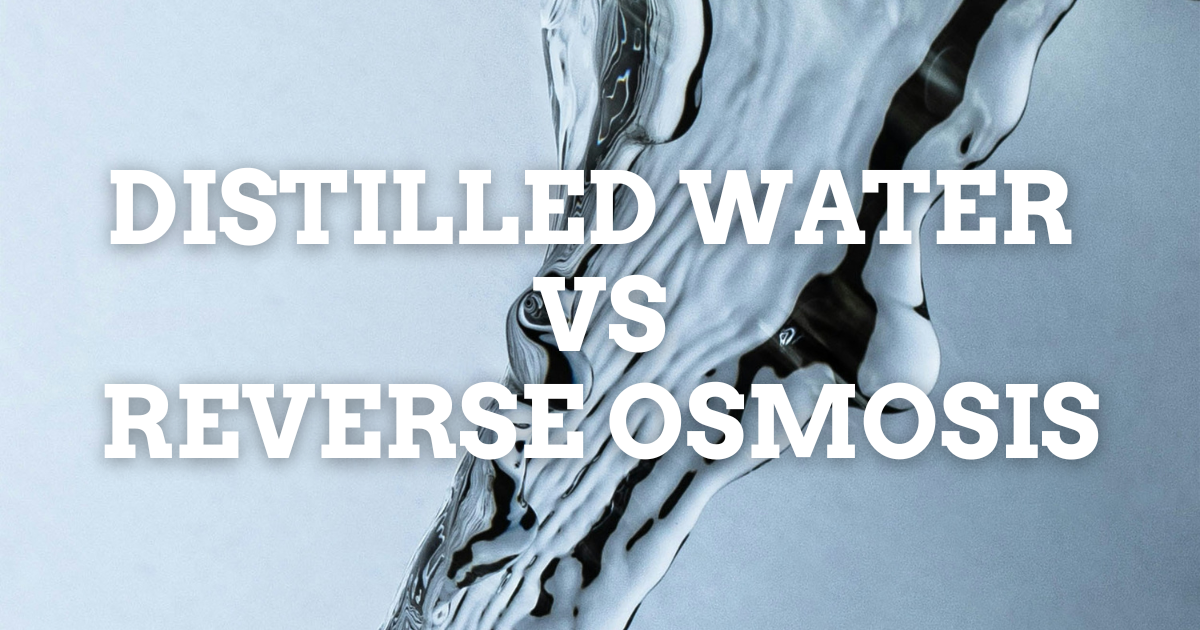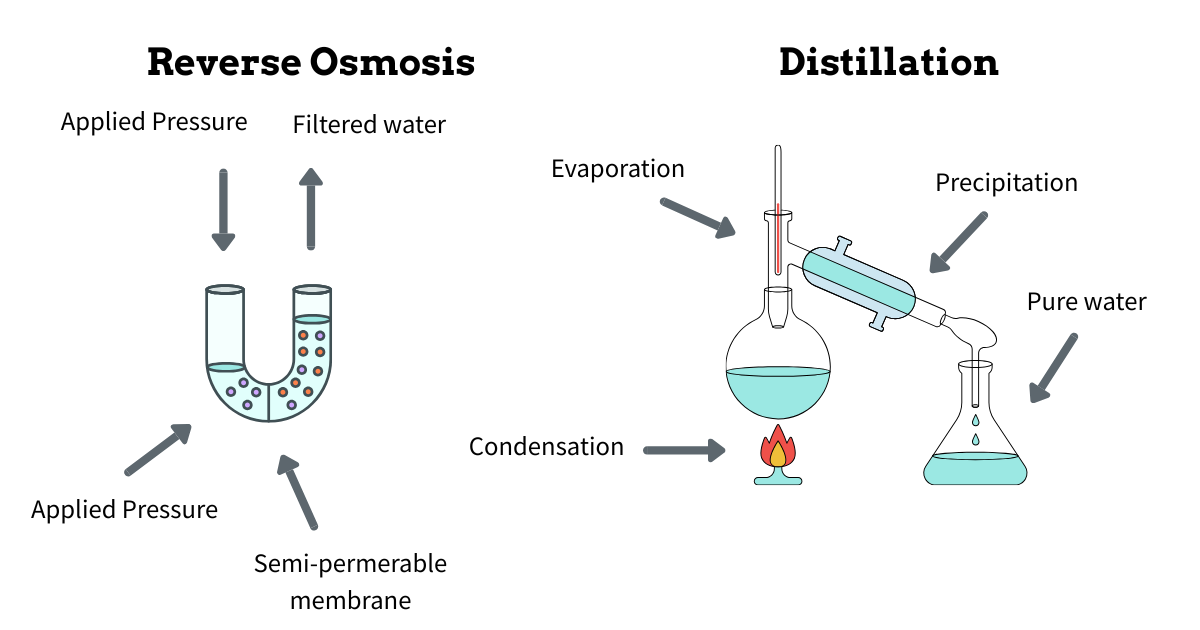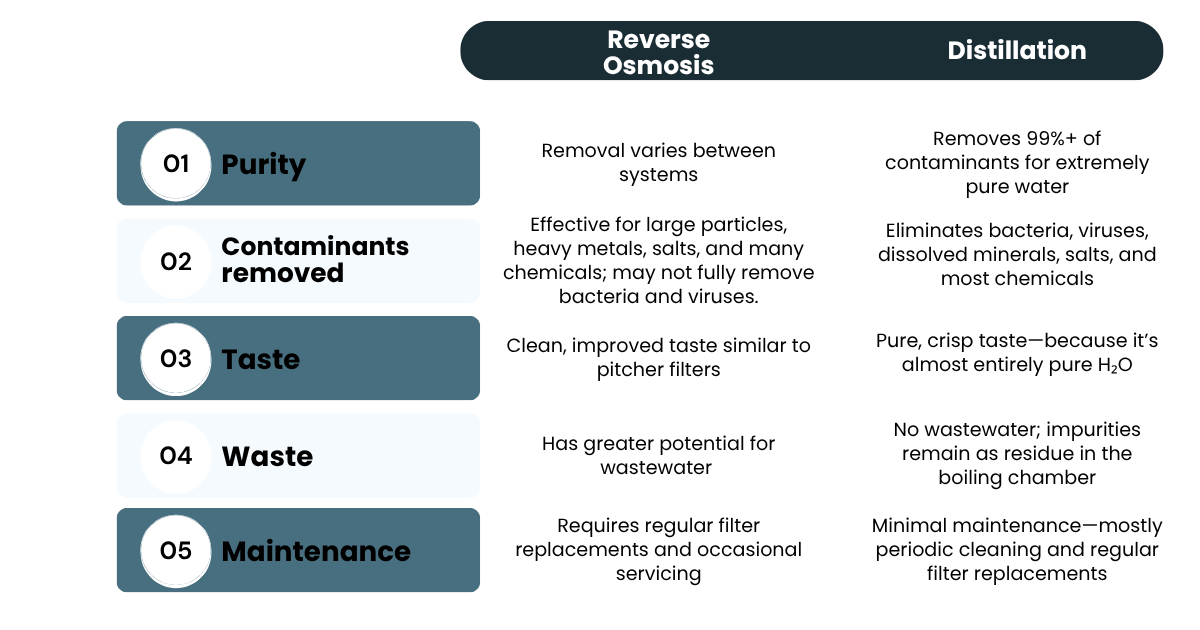Reverse Osmosis vs Distilled Water
When it comes to clean drinking water, two methods rise to the top of the list: reverse osmosis (RO) and distillation. Both remove impurities, but they work in different ways and can produce different results. Understanding these differences can help you decide which option is best for you, so that you can choose between distilled water and reverse osmosis.
What’s the need for purity?
Contaminants in drinking water are a serious issue in the U.S., affecting millions of people every day. These pollutants can come from many places—industrial waste, farm runoff, natural minerals in the ground, and even old pipes. Common contaminants like lead, arsenic, nitrates, and bacteria can be hazardous for children, pregnant women, and older adults. A well-known example is Flint, Michigan, where lead from corroding pipes caused long-term health problems for countless children.
The tricky part is that water contamination isn’t always obvious. You can’t always see it, taste it, or smell it. Chemicals like PFAS, often called “forever chemicals,” are increasingly appearing in water supplies nationwide. PFAS have been studied for potential links to health and environmental impacts, which is why reducing exposure is a growing public concern.
That’s why staying informed about your water and doing your part to purify it is so important. Checking your local water quality reports, doing at-home testing, and learning how your community treats its water can help you make wise choices—like adding a Pure Water Distiller to your home or pushing for better regulations and infrastructure in your city.
Water quality doesn’t just affect our health—it impacts the environment and entire communities. Poor water management can harm wildlife, damage crops, and hit lower-income communities the hardest. Clean water isn’t just a luxury; it’s a fundamental right. By staying aware and speaking up, we can all play a part in protecting safe, reliable water for everyone.
Below are the top contaminants found in drinking water in the US.
- Lead
- Arsenic
- Nitrates
- Chlorine and Chloramine
- PFAS (Per- and Polyfluoroalkyl Substances)
- Fluoride.
- Mercury
- Pesticides
- Radon
- Hexavalent Chromium (Chromium-6)
- Bacteria and Viruses
Purity Should Be The Priority
Purifying your drinking water isn’t just about taste but quality, confidence, and most importantly, safety. When you purify your water, you’re choosing cleaner, fresher, better-tasting water every time you pour a glass. By removing impurities, purified water reduces exposure to potential contaminants found in many local water sources.
Beyond taste, purified water helps protect your home and appliances. Removing minerals and impurities reduces buildup in kettles, coffee makers, humidifiers, and pipes, extending their lifespan and saving you money over time. It’s also a sustainable choice—when you have pure water at home, there’s less need for single-use plastic bottles.
Investing in water purification supports cleaner living and confidence in your water quality. It’s a simple change that delivers lasting benefits every day.
What Is Reverse Osmosis?
Reverse osmosis is a water filtration process designed to remove impurities by using pressure to force water through a semipermeable membrane. The membrane’s microscopic pores allow water molecules to pass through while blocking contaminants such as chemicals, salts, bacteria, and heavy metals.
A typical RO system includes several stages:
- Pre-filtration removes larger particles like sand and dirt.
- The RO membrane traps smaller contaminants.
- Post-filtration may be added to catch any remaining impurities.
Although effective, RO systems can be slow and often produce wastewater—several gallons may be discarded for each gallon of purified water. Some systems include a storage tank to improve flow, while others are tankless.
Why Install a Reverse Osmosis System?
Homeowners often install RO systems to improve drinking water quality and reduce exposure to contaminants sometimes present in municipal or well water. RO systems can be especially beneficial for:
- People with specific health concerns or weakened immune systems.
- Households in areas with poor water quality.
- Those who prefer the clean, crisp taste of filtered water over tap water.
Distillation is one of the oldest and most reliable methods of water purification. Distilled water is created through a natural purification process. As water is boiled, pure steam rises and separates from contaminants, which are left behind. The steam is then condensed back into liquid form—resulting in exceptionally pure water.
Pure Water Distillers are built with durable 304-grade stainless steel, and the purified water is collected in either a glass jar or a stainless steel storage tank. A carbon post filter is also used to capture any remaining VOCs, ensuring the cleanest water possible. The result is water that’s as pure as nature intended.
Distillation removes nearly all impurities, including bacteria, viruses, dissolved solids, salts, and chemicals with higher boiling points than water. Pure Water home water distillers also include a post-carbon filter to remove any residual volatile organic compounds (VOCs).
Why Install a Home Distiller?
According to Mt. Sinai in New York, nearly 1.8 million people die every year from water pollution worldwide. That’s a staggering number, and a reminder of how important clean drinking water is for our health. A water distiller is one of the most reliable and effective ways to remove both known and unknown contaminants from your water. With a Pure Water distiller, you don’t have to wonder whether your water is safe; you’ll know it is.
Pure Water Distillers has partnered with an independent, third-party lab to test the water produced by our distillers. The results show that distillation removes more contaminants than standard filters or reverse osmosis systems.
Distillation is widely considered the gold standard of water purification. Our water distillers produce water that is 99.9+% pure, and as a bonus, it tastes incredibly clean and refreshing.
Reverse Osmosis vs. Distillation: Key Comparisons
Safety of Reverse Osmosis Water
RO water is generally safe to drink and significantly cleaner than untreated tap water. However, it’s not the purest option available, and the water waste involved can be a drawback for those concerned with conservation.
Safety of Distilled Water
Distilled water is the purest form of drinking water, making it the top choice for individuals who want complete peace of mind about what’s in their glass. Its exceptional purity makes it ideal for anyone, including those with sensitive health needs. Drinking distilled water gives you peace of mind. You can drink with confidence, knowing your water is free from measurable impurities—no hidden toxins, no hard minerals you don’t want, just pure hydration. It’s ideal for cooking, making beverages, or supporting overall wellness, especially for those with sensitive systems or concerns about water quality. By choosing distilled water, you’re choosing consistency, safety, and health. It’s a simple step that protects your body, boosts hydration, and helps you feel confident that the water you drink is truly clean.
Cost of Reverse Osmosis vs. Distillation
RO systems typically require regular, often expensive filter changes and may need professional servicing over time. The average cost of an RO system can vary depending on the specific system being installed, and they do have a yearly maintenance fee for upkeep.
Distillers, on the other hand, involve minimal ongoing costs—mainly periodic cleaning to remove mineral buildup, while also keeping up on changing carbon filters. Pure Water distillers are built to last for decades, with parts readily available and industry-leading warranties. Plus, with over 50 years of service and U.S.-based support, you’ll always have help when you need it.
Choosing Between Reverse Osmosis and Distillation
Both methods improve water quality, but distillation provides the highest level of purity. As contaminants like PFAS, nitrates, microplastics, and pesticides become more prevalent, having a Pure Water distiller offers true peace of mind.
So, distilled water or reverse osmosis? If your goal is to provide your family with the cleanest, most reliable drinking water possible, distillation is the superior choice.







Leave a Reply